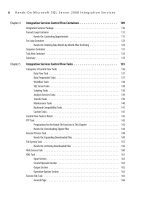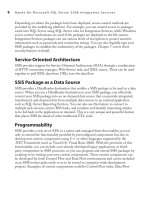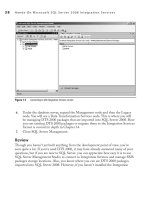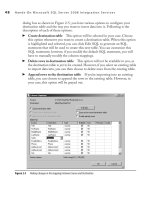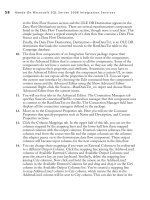Hands-On Microsoft SQL Server 2008 Integration Services part 18 pot
Bạn đang xem bản rút gọn của tài liệu. Xem và tải ngay bản đầy đủ của tài liệu tại đây (317.89 KB, 10 trang )
148 Hands-On Microsoft SQL Server 2008 Integration Services
Review
In this Hands-On exercise, you learned to use the FTP task to download multiple files
from a remote FTP server. You have hard-coded file paths for the RemotePath and
LocalPath fields in this exercise. However, you can use variables to change these folders
dynamically during run time and download or upload files to different folders each
time the package is run. For example, you can download files to the folders derived on
the basis of date—for instance, the folder name includes the date as a part of the name
(such as Zip20091011). So, in that case, when the package is run, the path variable is
calculated dynamically based on the current date and loads the files to the current date
folder. Variables are not the only means to derive values dynamically. SSIS enables you
to derive values dynamically at run time, based on the outcome or values generated by
other tasks, using property expressions as well that do not necessarily contain variables
in their expressions. You have been introduced to the property expressions in Chapter 3
and will learn more about them in Chapter 8.
Execute Process Task
Generally enterprises have home-grown or custom-developed applications to apply
business processes to the information they deal with. These applications might be to
make sure that the information goes to right people in the right format after corporate
standards are applied on to it, or it might be a custom application to transform a
mainframe encrypted and compressed (such as EBCDIC format) file into a standard
text format file. The company might wish to reuse the functionality that already exists
and has been accepted within the corporate setting. Integration Services allows you
to leverage your existing investment and bring those processes in the workflow within
the packages by using the Execute Process task. With this task, you can run a business
application or a batch file to perform specific business functions that already exist or
can’t be developed easily in SSIS; the good thing about this is that the output from
running the business application or batch file can then be included in the SSIS package
workflow. You could unzip files, call custom programs to break a huge file into smaller
files that can be easily handled for transformation operations, run a custom report
generation application from within SSIS, and then use a Send Mail task to distribute
those reports. To keep it simple, we will use this task to unzip the files you have
downloaded from the FTP server in the preceding Hands-On exercise.
You have begun your journey to understand the SSIS workflow. In the last Hands-On
exercise, you downloaded zipped files from an FTP server in the C:\SSIS\ downloads
folder. In the next exercise, you will unzip the downloaded files using the Execute
Process task, which will run a batch file to do the trick.
Chapter 5: Integration Services Control Flow Tasks 149
Hands-On: Expanding Downloaded Files
Adventure Works Bikes dealers’ reports need to be downloaded and extracted so that
they can be imported into the SQL Server database. You have already downloaded
these files; here you will extract flat files from the downloaded files.
Method
You have downloaded zipped files DealerSales01.zip and DealerSales02.zip in the
C:\SSIS\downloads folder but can’t use these files, as SSIS can’t read zipped files.
You need to extract flat files from the zipped files to be able to import them into SQL
Server using SSIS. You will run a batch file to extract the flat files from the zipped
files and will deploy an Execute Process task to run this batch file at run time. Because
you want to unzip more than one file, you will enumerate the files you want to unzip;
an enumeration function will be provided by a Foreach Loop Container. In the last
chapter, you used a Foreach Loop Container with the Foreach ADO enumerator to
enumerate over rows; now you will be using the Foreach File enumerator to enumerate
over files. The steps for this will be:
Create a batch file to expand the downloaded Zip file.
c
Use a Foreach Loop Container to enumerate over multiple Zip files. c
Add an Execute Process task to call a batch file from within the SSIS package to c
extract the flat files.
Exercise (Creating Batch File)
The downloaded files have been compressed using a Freezip freeware package that
has been included in the distribution software provided for this book. Go to C:\SSIS\
Freeware\Freezip to find the software files there. However, if you use some other
software utility to compress files, you can use a command-line interface of that utility to
unzip files in the same manner as shown in this exercise.
Open a blank text file using Notepad and type the following commands:
DEL C:\SSIS\downloads\%1.txt
C:\SSIS\Freeware\Freezip\UNZIP %1.zip %1.txt
The first line deletes the previously present text file, and the second line extracts a
text file from the Zip file specified as an argument in the command. Save the file as
C:\SSIS\RawFiles\ExtractFiles.bat. Make sure that the file has been saved with the
.bat extension and not with the .txt extension. This file should already be available in
the RawFiles folder, as it has been included in the distribution software provided for
this book.
150 Hands-On Microsoft SQL Server 2008 Integration Services
Exercise (Enumerating Multiple Zipped Files)
You will add and configure a Foreach Loop Container to enumerate over the Zip files
in the downloads folder and populate the fname variable with the filename.
1. Start BIDS and open the Control Flow Tasks project. Go to Solution Explorer
and right-click the SSIS Packages folder in the Control Flow Tasks project and
choose New SSIS Package from the context menu. This will add a new package
called Package1.dtsx in the project.
2. Right-click Package1.dtsx and rename it as Expanding downloaded files.dtsx.
3. Drop a Foreach Loop Container from the Toolbox onto the designer surface and
open the editor by double-clicking it. Type the following in the General page:
Name Enumerating Zip Files
Description This task enumerates Zip files in the C:\SSIS\downloads folder.
4. Go to Collection page and make sure Foreach File Enumerator is selected in the
Enumerator field.
5. In the Enumerator configuration area, specify C:\SSIS\downloads in the Folder field
either by typing it in directly or by using the Browse button to select the folder. You
can enumerate multiple files of the same type with the Foreach Loop Container at
one time. For this, you can use the Files field to limit or select precisely the files of
one type you want to access in a folder containing different types of files. In the Files
field, type *.zip to specify the types of files you want the Foreach Loop Container
to enumerate on (refer Figure 5-3). Use the Files field to limit or select precisely the
files you want to access in a folder containing different types of files.
6. The most interesting bit in this page is the Retrieve File Name section. This is
where you will choose how the filename should be retrieved from three options.
Before you jump into selecting one of the options, you must understand what these
options are and how they work. The filename is treated in SSIS as consisting of
three parts: the path pointing to the location where the file might be stored, the
name portion of the file, and the extension of the file indicating its type.
Fully Qualified This option will return the path, the filename, and the extension all as a single
string. The path portion of the filename can be a full folder path in a universal
naming convention (UNC) or absolute form. For example, the fully qualified name
retrieved can be \\ComputerName\Sales\DealerSales01.zip, or it can be in
the form C:\SSIS\downloads\DealerSales01.zip, depending on what you have
specified in the Folder field.
Name And Extension Choosing this option returns the name portion of the filename along with its
extension—for example, DealerSales01.zip.
Name Only Choosing this option will return only the name portion of the filename—for
example, DealerSales01.
Chapter 5: Integration Services Control Flow Tasks 151
Select Name only, as you will need only the name of the file to be passed as an
argument to the batch file.
7. Go to the Variable Mappings page, click in the Variable field, and select <New
Variable…> to create a new variable. Name the variable fname in the Expanding
Download Files Container with the string type value and return to the Foreach
Loop Editor. Note that the Index field has automatically been allocated a value
of 0 for this variable. Make sure that you type the variable name in lowercase—
fname—as the variables are case sensitive. Click OK to complete the Foreach
Loop Container’s configuration.
Figure 5-3 Configuring the Foreach Loop Container with the Foreach file enumerator
152 Hands-On Microsoft SQL Server 2008 Integration Services
Exercise (Calling Batch File Using Execute Process Task)
Now you will add Execute Process task inside the Foreach Loop Container. This
task will use the fname variable populated by Foreach Loop Container to pass as an
argument to the ExtractFiles.bat file.
8. Drag and drop the Execute Process task from the Toolbox within the Foreach
Loop Container and double-click it to open the Execute Process Task Editor.
Type the following in the General page of the task editor:
Name Call ExtractFiles batch file
Description This task extracts DealerSales flat files.
9. Go to Process page to configure options for this task. Verify that the
RequireFullFileName field has the default True selected. This means that the
task will fail if it cannot find the batch file at specified location.
10. In the Executable field, specify C:\SSIS\RawFiles\ExtractFiles.bat to point the
task to the batch file.
11. You need to specify the filename as an argument to the batch file. The filename
argument has been populated in the fname variable in the earlier part of this
exercise. However, Arguments field doesn’t allow use of a variable, so you will
be using property expressions in the next step to attach the fname variable to the
Arguments field. Leave the Arguments field blank for the moment and in the
WorkingDirectory field, specify C:\SSIS\downloads, as shown in Figure 5-4.
In the next three fields, you can use variables for the input, output, or error values
as explained here:
c StandardInputVariable Specify a variable to provide the input to the
process.
�c StandardOutputVariable Specify a variable to capture the output of the
process.
c StandardErrorVariable Specify a variable to capture the error output of the
process.
You are not using these fields for this exercise, so leave them blank. Using the
FailTaskIfReturnCodeIsNotSuccessValue field, you can configure the task to fail
if the process exit code does not match the value you provide in the SuccessValue
field. Also, you can specify a time-out value in seconds and choose to terminate
the task after time-out period. Finally, if it is important, you can choose the
window style in which the task starts a process. Leave these fields set at their
default values and move on to the Expressions page.
Chapter 5: Integration Services Control Flow Tasks 153
12. In this step, you will pass the value of the fname variable to the Arguments
field using property expressions. Property expressions are explained in detail in
Chapter 8, but here for a quick introduction, property expressions will apply the
run-time values of the fname variable on to the Arguments property. Click the
ellipsis button in the Expressions field to open the Property Expressions Editor.
Click in the Property field and select Arguments from the drop-down list. Click
the ellipsis button in the Expression field to open an Expression Builder dialog
box. Expand Variables in the left pane of the window and locate the User::fname
variable in the list. Drag this variable and drop it in the Expression box. Click OK
three times to close the task editor.
13. Press 5 to start debugging the task. You should see the tasks turning quickly
from yellow to green (see Figure 5-5).
Figure 5-4 Configuration of the Execute Process task
154 Hands-On Microsoft SQL Server 2008 Integration Services
13. Press -- to save all the files in this project and then choose File |
Close Project.
14. Go to the downloads folder and see that the DealerSales01.txt and DealerSales02
.txt files have been extracted.
Review
You have learned how to use the Execute Process task to expand the zipped files in this
Hands-On exercise. Now you know that SSIS provides an option to run the custom-built
applications that you need to use for your day-to-day functions. Also, not only can you run
custom-built applications, but you can also use the results of running such an application
by using the StandardOutputVariable property and use this value in other places in the
package such as building a workflow expression.
Figure 5-5 Executing the Expanding downloaded files.dtsx package
Chapter 5: Integration Services Control Flow Tasks 155
File System Task
The File System task allows you to perform operations on the files and directories in
the file system. You will be using this task in your packages to perform operations such
as copy, delete, and move on files and folders. If you have used DTS 2000, you might
have written ActiveX code to rename, copy, or move files or folders. Though you may
still have to write a piece of code in the Script task to perform some of the complex
operations, most of your requirements for performing operations on files and folders
can be met by using the File System task and hence less code to maintain.
In the Task Editor of File System task, you will see an Operation field that offers a
drop-down list of operations it can perform. Following are the brief descriptions of the
operations that the File System task can perform:
Copy directory
c Copies a folder from one location to another.
Copy file c Copies a file from one location to another.
Create directory c Creates a directory in a specified location.
Delete directory c Deletes a directory from a specified location.
Delete directory content c Deletes all the files and folders in the specified directory.
Delete file c Deletes the specified file.
Move directory c Moves a folder from one location to another.
Move file c Moves a file from one location to another location.
Rename file c Renames a file in the specified location. You can actually move
the file to a new location while renaming by specifying a new path in the name,
though you cannot rename the file while moving it to a new location.
Set attributes
c Sets Archive, Hidden, ReadOnly, and System attributes on the
files and folders. If you do not specify any attribute in your selections, the Normal
attribute will be applied, which is exclusive to all the other attributes.
The File System task has a dynamic layout in which the available fields change
depending on the operation you choose. For example, the Delete Directory, Delete
Directory Content, and Delete File Operations do not use a destination, and hence
the DestinationConnection field doesn’t appear when you choose any of these
operations. The SourceConnection, however, is used by all of the operations. The
SourceConnection and the DestinationConnection can be specified by using a File
Connection Manager to refer to a file or a folder or by providing a variable that
contains the connection strings.
156 Hands-On Microsoft SQL Server 2008 Integration Services
The following Hands-On exercise for this task will help you understand the
configuration options. In the earlier exercises, you have downloaded and unzipped
the dealer sales files and hence have compressed Zip files and uncompressed text files
in the C:\SSIS\downloads folder. Your next problem is to archive the Zip files for
historical purposes.
Hands-On: Archiving Downloaded Files
The downloaded reports of dealers of Adventure Works Bikes are to be archived for
historical purposes. You want to keep the downloaded zipped files in the Archive folder.
Method
In this exercise, you will use the Foreach Loop Container and the File System task to
copy these files one by one to the C:\SSIS\downloads\Archive folder. The step-by-step
method is as follows:
Configure the Foreach Loop Container to enumerate over files and house the File
c
System task in it. Your File System task will copy one file with each iteration to
the Archive folder.
Configure the File System task to move files to the Archive folder one by one with c
each iteration of the Foreach Loop Container.
Exercise (Configure Foreach Loop Container)
In first part of the exercise you will configure the Foreach Loop Container to
enumerate files using Foreach File enumerator and populate a variable with the
filename. This variable will be used by File System task to determine the name of the
file to be copied over.
1. Open the Control Flow Tasks project in BIDS. Go to the Solution Explorer,
right-click the SSIS Packages folder, and choose New SSIS Package from the
context menu. This will add a new package, Package1.dtsx, to the project.
2. Right-click Package1.dtsx and rename it as Archiving downloaded files.dtsx.
3. From the Toolbox, drag and drop the Foreach Loop Container onto the Control
Flow panel.
4. Make sure that the Foreach Loop Container is selected; open the Variables window
from the default position on the left side of the BIDS interface. Alternatively, click
the Foreach Loop Container and choose View | Other Windows | Variables.
Chapter 5: Integration Services Control Flow Tasks 157
Click Add Variable, the left-most button in the toolbar of the Variables window.
Specify the following for this variable:
Name Fname
Scope Foreach Loop Container
Data Type String
Value Xyz
The value you’ve assigned to fname variable will be changed at run time when the
Foreach Loop Container reads the filename and populates this variable during
each iteration. The value assigned is just a placeholder value, so you can realize
the Fname variable changes values dynamically. Last, be careful with the case of
the Name field, as SSIS variables are case-sensitive.
5. Right-click the Foreach Loop Container and choose Edit from the context menu
to open the Foreach Loop Editor. In the General page of the container, type the
following:
Name Enumerating Files
Description This container enumerates the files and populates the fname variable.
6. Go to the Collection page. Make sure it shows the Foreach File Enumerator in
the Enumerator field and specify the options shown in Figure 5-6.
Enumerator Foreach File Enumerator
Folder C:\SSIS\downloads
Files *.zip
Retrieve file name Fully qualified
7. Move on to Variable Mappings page. You will map fname variable to the filename
retrieved by the Foreach Loop Container so that later on in the package you can
get the filename by the fname variable. Click in the highlighted area under the
Variable column and then click the drop-down arrow that appears. From the drop-
down list, select the variable User::fname, configured earlier in the exercise. A 0 will
appear under the Index field. Index indicates the position of the string within the
collection. As you will be accessing only one filename at a time, Index will be set
to 0. Click OK to close the Foreach Loop Editor.


